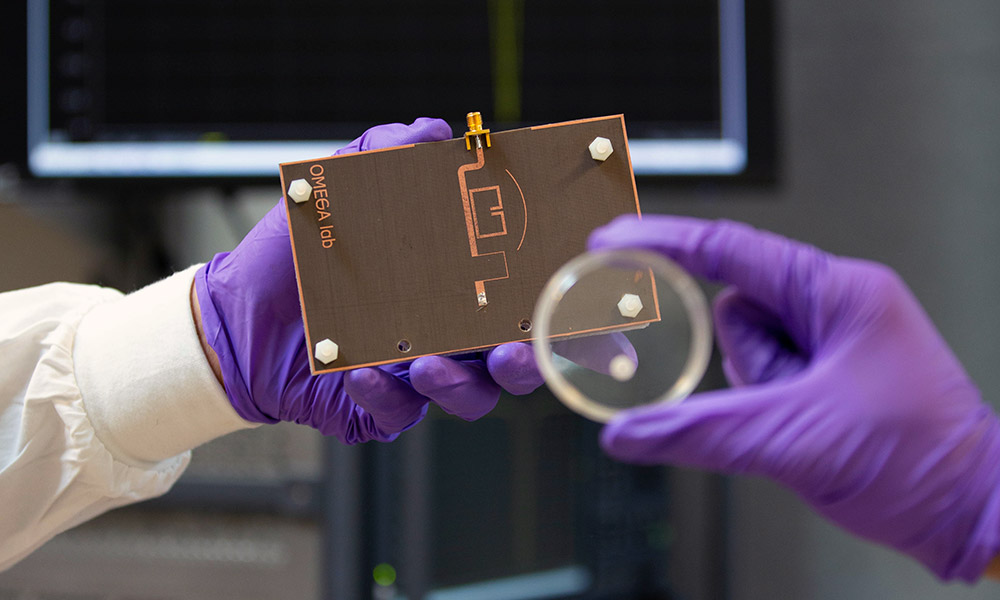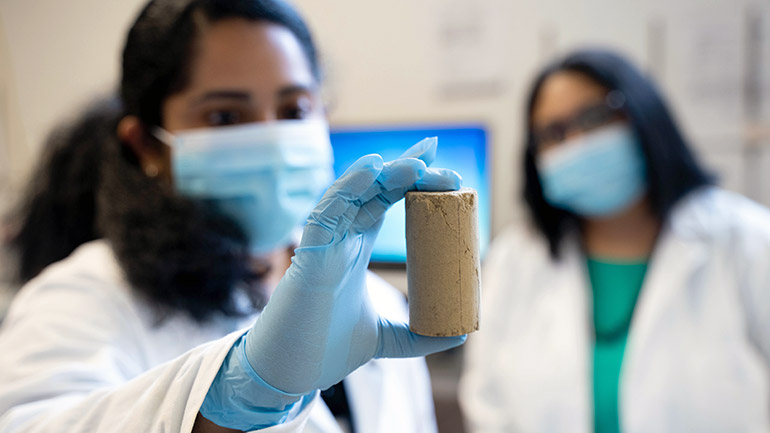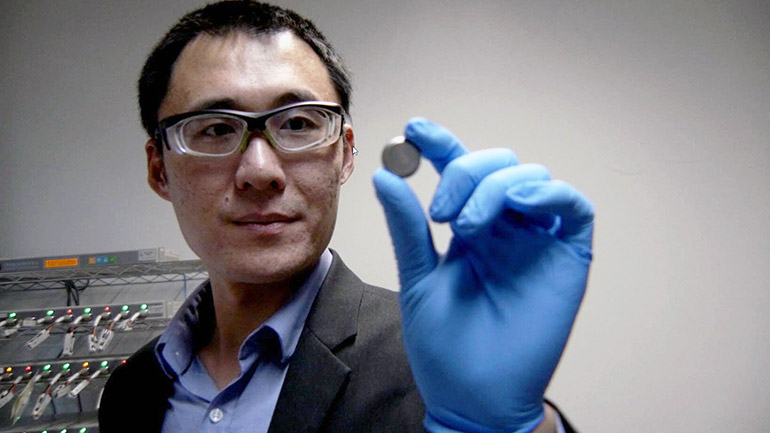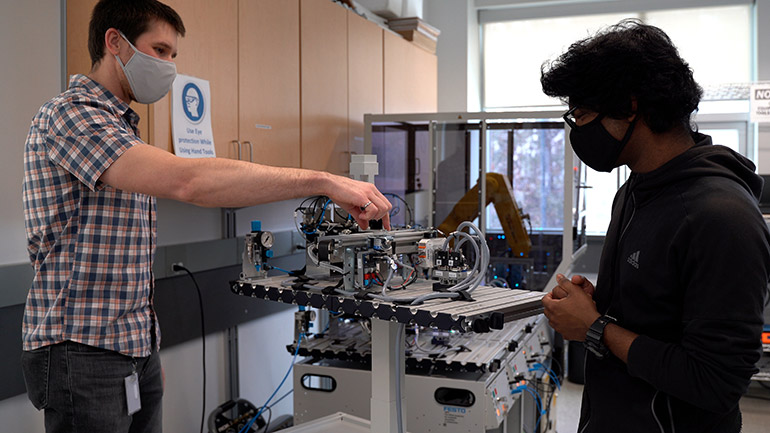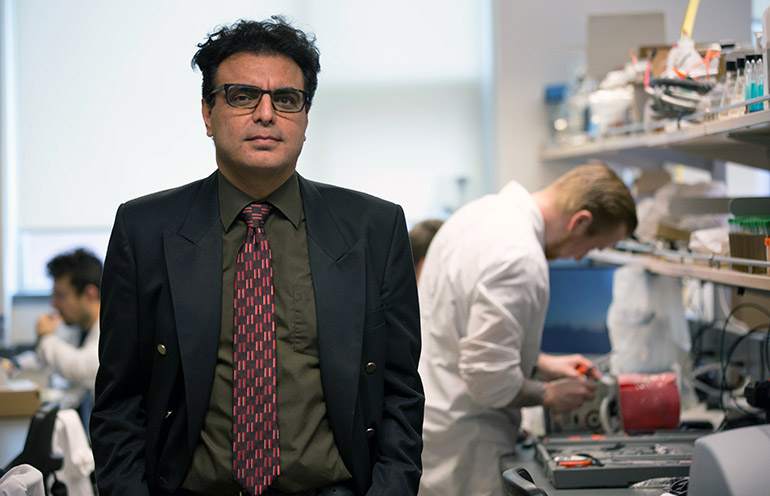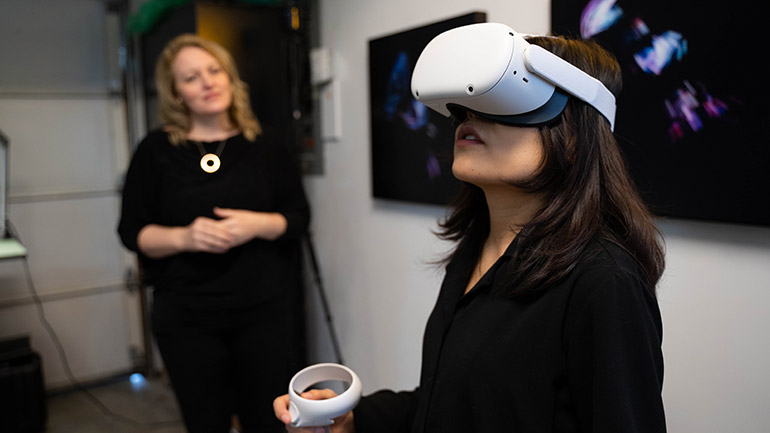
UBCO Associate Professor Megan Smith along with student Yugi Goa explore a virtual reality environment.
$1.65 million federal grant creates futuristic learning and applied research opportunities
Funding from the Government of Canada will help establish one of the world’s first truly interdisciplinary immersive technologies graduate programs at UBC’s Okanagan campus.
The
$1.65-million grant from the Natural Sciences and Engineering Research Council of Canada’s Collaborative Research and Training Experience (CREATE) program will support UBCO’s newly-established CREATE Immersive Technologies (CITech) program.
Dr. Abbas S. Milani, a professor in the School of Engineering and CITech lead, says the program will help students develop skills in immersive technologies that are in demand across Canada and globally. Immersive technologies, such as augmented and virtual reality systems, enable users to interact naturally with a blended environment of physical and virtual content.
“There is currently a huge demand for adopting virtual, augmented and mixed reality systems across the globe,” says Milani. “This new program will equip students with the skills to flourish in the fast-paced, continually evolving field of immersive technologies.”
An additional $2.5 million from other partners will help UBC develop multiple and innovative cross-departmental courses.
CITech will provide multi-faculty co-supervision, multidisciplinary research projects, and industry mentorships from across Canada, says Milani, who is the founding director of the UBC Materials and Manufacturing Research Institute (MMRI).
This new endeavour will link researchers, students and partners from traditionally distinct sectors such as engineering, creative and critical studies, medicine, nursing, education and computer science.
The program will establish a large and diverse cohort of students each year, who will develop immersive technology skills through multidisciplinary course work along with basic and applied research. They will work and study in an integrated setting that will include computational, engineering, smart manufacturing, health and artistic design perspectives.
“Collaborations between our faculties, our campus and industry, along with our researchers and the community are the perfect incubator for training the high-tech workers of tomorrow,” he adds.
Milani and his co-applicants believe that UBC Okanagan provides an ideal environment for training the next generation of leaders in immersive technology.
“To make the biggest impact with this program, contributions from arts and health are imperative,” he adds. “Integrating the arts recognizes a more holistic science, technology, engineering, arts and mathematics (STEAM) strategy, and the engagement of health researchers acknowledges the substantial projected impact of immersive technologies on the Canadian health-care sector.”
The program will take advantage of UBC Okanagan’s state-of-the-art Visualization and Emerging Media Studio, set to open later this summer, along with other high-tech labs across the campus.
Mahdi Takaffoli, MMRI research engineer and CITech coordinator, points to the program’s collaboration with 18 initial industry partners, in addition to Interior Health and the City of Kelowna, as a major indicator that the skills being taught in this program are highly sought after.
“There is a significant skills gap in terms of designing and building immersive solutions that solve tangible problems,” says Takaffoli. “And this program seeks to address this gap through professional development opportunities, cutting-edge research projects and real-world experiential learning.”
From formal co-mentorship, professional skills and job-readiness training, industrial internships, symposiums and inter-disciplinary research, students in the program will strive to uncover innovative methods of implementing immersive technologies into a wide range of applications including design, engineering, health care, education and the arts.
“This program will lay a strong foundation for our students and community partners to address future challenges,” says Milani. “The upcoming projects are far-reaching and have endless potential for continued research.
One of the proposed projects will use virtual reality to determine a pedestrian’s reaction to an approaching autonomous vehicle, while another will help post-stroke patients gain strength to reduce the risk of falling.
Other projects will investigate how virtual technology can support the learning of Indigenous languages, or help advanced manufacturing sectors assess the quality and safety of their procedures and products, and one future project will look at the use of immersive visualization to create 3D, interactive e-commerce venues.
The growth potential is limited only by the team’s imagination, says Milani, who notes there are plans to expand the CITech program over the next few years and develop a national centre of excellence with other Canadian universities.
About UBC's Okanagan campus
UBC’s Okanagan campus is an innovative hub for research and learning founded in 2005 in partnership with local Indigenous peoples, the Syilx Okanagan Nation, in whose territory the campus resides. As part of UBC—ranked among the world’s top 20 public universities—the Okanagan campus combines a globally recognized UBC education with a tight-knit and entrepreneurial community that welcomes students and faculty from around the world in British Columbia’s stunning Okanagan Valley.
To find out more, visit:
ok.ubc.ca
